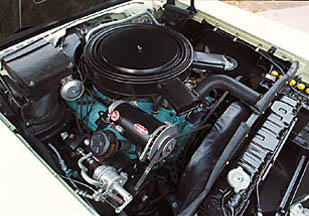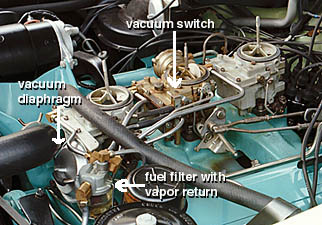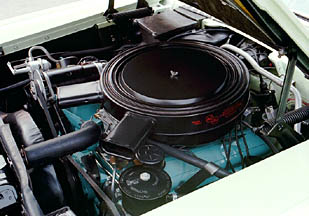|
|
|
|
|
|
engine details on Kris Trexler's |
|
|
|
 |
|
|
|
|
|
|
|
|
|
|
|
 |
| Pontiac's "Tempest 395" engine actually had 370 cu. in. displacement. The "395" stood for the foot-pounds of torque the engine delivered. In the 50's, big numbers counted! Pontiac obviously hoped to fool the public into believing the engine was bigger than it actually was. They claimed it to be "the most efficient power plant of all time!" with "jeweled-action response!" (whatever that means). |
 |
|
|
| Because this particular Bonneville is one of the 2% of '58 Pontiacs delivered with factory air conditioning, there are a few differences in the engine compartment. The 50 ampere generator has a different pulley than other GM/Delco generators of the period - note that the generator cooling fins are on a backing plate behind the drive pulley. The special voltage regulator is a hard to find item. The generator is mounted on a special bracket to make room for the a/c compressor and GM's unique Frigidaire "hot-gas bypass valve" (the silver colored valve below the oil fill cap) which controls a/c outlet temperature - this car gets COLD inside on a hot day! The a/c evaporator and blower are located in the large black apparatus on the passenger side firewall. A '58 Pontiac engine compartment with air conditioning is quite cramped, and the only access to the front spark plugs on this side of the car is through the left front wheel well with the tire removed. The oil dipstick tube was rerouted around the a/c hot gas valve - the dipstick is considerably longer on an a/c equipped '58 Pontiac as a result. |
|
|
|
|
|
|
 |
|
| The "Tri Power" carburetion system features three 2-barrel carburetors. The center carburetor on this car is an N.O.S. (new old stock) unit with its original gold-colored plating - the front and rear carbs have been restored, but the color of the plating is unfortunately not as rich as the N.O.S. unit. |
 |
|
| Here's how Tri Power works: the engine runs on the primary (center) carburetor most of the time. The secondary (front and rear) carbs are operated by vacuum control: when the accelerator pedal is pushed to approx. 1/2" from the floorboard, the linkage rod from the pedal to the center carb actuates a vacuum switch which allows intake manifold vacuum to pass through the switch to a vacuum diaphragm. The diaphragm pulls on a linkage rod which opens both secondary carburetors FULLY - there is no partial operation of the secondary carbs - when they come on, the engine ROARS to full power. The rush of acceleration is exhilarating, to say the least! Many Tri Power setups on GM cars of this vintage have been either disconnected or converted to a later-style mechanical "progressive" linkage, eliminating the stock vacuum control which is prone to failure. New vacuum diaphragms are impossible to find - fortunately, I located a company that rebuilt the original vacuum diaphragm with new internal rubber parts and fresh cadmium plating for a very reasonable price.
Note the glass-bowl fuel filter - cars equipped with factory air conditioning have a special vapor-return outlet to the fuel tank to help alleviate "vapor lock," a common malady of the period (the result of a hot engine causing liquid gasoline to vaporize in the fuel lines - the fuel pump is designed to pump liquid, not vapor. The result: a stalled engine until the fuel in the lines has cooled enough to re-liquify). The vapor-return attempts to rectify this problem.
|
|
|
|
|
|
|
 |
|
| The large air cleaner almost completely hides all the elaborate Tri Power plumbing, which is why many original owners replaced it with small individual aftermarket chrome air cleaners - a simple way to show off all that carburetion! |
 |
|
| Unfortunately, this one-year-only air cleaner is frequently missing, making authentic restoration difficult and expensive. Used '58 Pontiac Tri Power air cleaners requiring repair and painting have sold for upwards of $1,500! The "AC" air filter information (silk screened in red on the side of the air cleaner) is usually applied by a reproduction sticker. I was fortunate that a friend with "connections" offered to authentically silk-screen this unit. |
|


![]()
![]()
![]()

![]()
![]()

![]()
